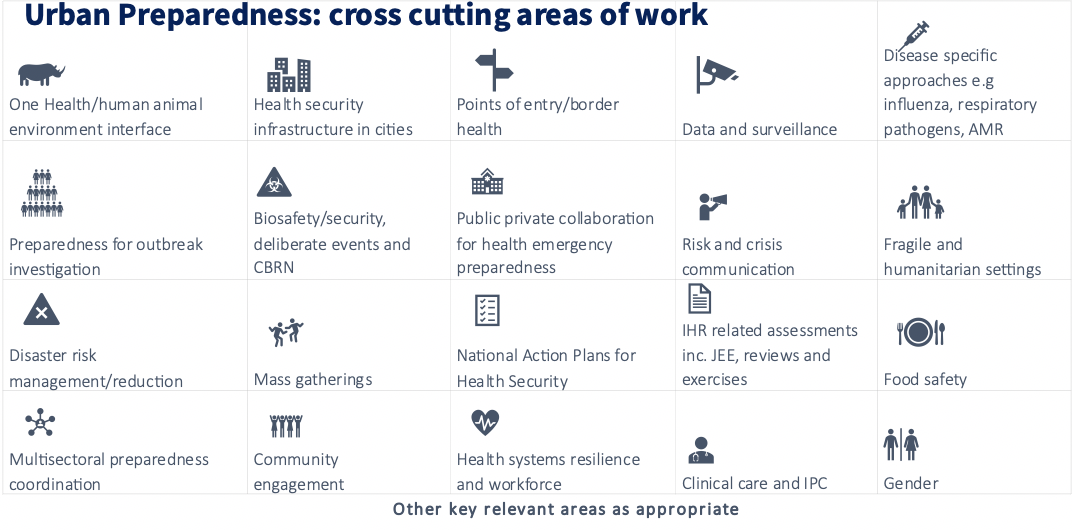
Urban Health Emergency Preparedness
Urban Preparedness
Urban Health Emergency Preparedness
WHO is exploring collaborating with the Korea Disease Control and Prevention Agency (KCDC), in the context of the newly opened Global Health Security (GHS) Coordination Office. Urban Preparedness, and in particular sharing the lessons learned and good practices gleaned from the COVID-19 pandemic and other health emergencies and outbreaks is a key part of future global health security co-ordination for global health security.
Despite substantive progress having been made in health security and health emergency preparedness globally, as well as the implementation of the International Health Regulations (2005) (IHR), significant gaps and challenges persist across countries, at both national and sub-national levels. The importance of emergency preparedness and health security has been underscored over the course of the COVID-19 pandemic and other recent health emergencies and disasters.
Cities and urban settings are crucial to preventing, preparing for, responding to, and recovering from health emergencies, and therefore enhancing the focus on urban settings is necessary for countries pursuing improved overall health security. Given the population density of cities, their role as hubs of trade and commerce, and movement of people and goods, cities are key settings to achieve better preparedness for health emergencies. As well as having responsibilities for health service delivery, municipal governments often provide essential infrastructure and services linked to water, sanitation and hygiene, transport, and energy provision – all critical to protecting health.
Health threats at the human-animal-environment interface are critical to address to prevent and prepare for future pandemics. Rapid urbanization, population growth and aggregation, increased interface with livestock, wild animals, and vectors in the diversity of anthropized ecosystems, particularly in urban areas, are factors adding epidemiological challenges and increasing emerging and re-emerging disease risks and health burdens for populations living in these ecosystems. Intensified movement of people, animals, food, and trade provides additional favourable grounds for the rapid dissemination of infectious diseases, including zoonoses.
There is also a need to better understand the gaps and weaknesses in the preparedness of systems and associated infrastructure. Experience has shown us that health security threats affect both global, regional, and national levels and it will continue to occur in unpredictable ways that will challenge even the most advanced health systems. This infrastructure often sits in cities, making them an entry point for building the resilient systems that are needed in the face of future threats. Furthermore, this infrastructure also leaves cities vulnerable as cities targets for biosecurity events – naturally occurring, deliberate or accidental in nature and the associated health threats from these events.
Time to act
At the 75th World Health Assembly in May 2022, WHO Member States adopted WHA Resolution 75.7 on Strengthening health emergency preparedness and response in cities and urban settings. The resolution outlines the importance of cities and urban settings to health security and emergency preparedness, and focuses on the implementation of the global Framework to Strengthen Health Emergency Preparedness in Cities and Urban Settings.
Through WHA 75.7 WHO Member States have underlined the timeliness and importance of acting now – urban health emergency preparedness provides a key and timely opportunity to make the practical difference to country health emergency preparedness that is required by the threats posed by the pandemic and other health emergencies.

WHO is working to support countries to strengthen urban health emergency preparedness in the context of WHA 75.7 implementation. Effectively addressing these challenges includes better integration of municipal authorities into health security and health emergency preparedness activities, often ongoing predominantly at the national level, as well as building the capacities at the city level to address identified risks and challenges. Existing WHO guidance focussing on the national level can be adapted to local and city contexts, ensuring we are enhancing our national preparedness through the contextualised approach in cities that is so urgently needed.
The article in the first Global Health Security Coordination Office Newsletter can be accessed at: 질병관리청 GHSCO 뉴스레터 (ghsconewsletter.or.kr)